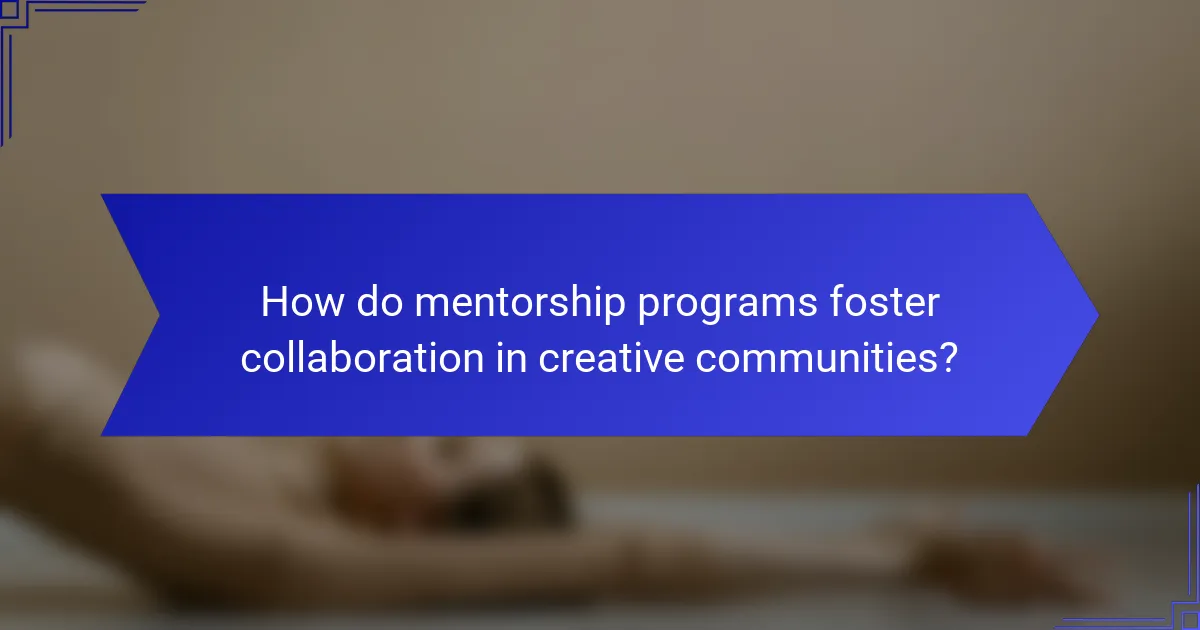Creative mentorship programs play a crucial role in nurturing artistic talent and fostering community engagement within creative hubs like New York and Los Angeles. By connecting emerging artists with experienced professionals, these programs facilitate skill development, networking, and collaboration, ultimately enriching the creative landscape. Through guidance and resource access, they empower individuals to thrive and contribute innovative ideas to their communities.

How do creative mentorship programs benefit artists in New York?
Creative mentorship programs in New York provide artists with invaluable support through guidance, networking, and access to resources. These programs help foster artistic growth and community engagement, allowing emerging artists to thrive in a competitive environment.
Networking opportunities
Networking is a crucial aspect of creative mentorship programs, enabling artists to connect with established professionals in their field. These connections can lead to collaborations, exhibitions, and job opportunities that might not be accessible otherwise.
Participating in workshops, events, and showcases organized by mentorship programs can significantly expand an artist’s network. Engaging with peers and mentors fosters relationships that can provide ongoing support and inspiration throughout an artist’s career.
Skill development
Skill development is a primary focus of creative mentorship programs, offering tailored guidance to help artists refine their craft. Mentors often provide feedback on techniques, concepts, and artistic direction, which can enhance an artist’s abilities and confidence.
Workshops and hands-on sessions are common in these programs, allowing artists to learn new skills or improve existing ones. This practical experience can be essential for artists looking to adapt to changing trends or explore new mediums.
Access to resources
Access to resources is another significant benefit of creative mentorship programs in New York. Many programs provide artists with tools, materials, and studio space that they might not afford on their own, which can be critical for their creative process.
Additionally, mentorship programs often connect artists with funding opportunities, grants, and exhibitions. This access can help artists gain visibility and financial support, which are essential for sustaining their artistic endeavors.

What are the top creative mentorship programs in Los Angeles?
Los Angeles hosts several prominent creative mentorship programs that connect emerging artists and professionals with experienced mentors. These programs foster skill development, networking, and collaboration within the vibrant creative community of the city.
Creative Capital
Creative Capital is a national organization that supports artists through funding and mentorship. In Los Angeles, they provide resources for artists to develop their projects and connect with industry leaders. Participants receive guidance on project management, fundraising, and marketing strategies.
To apply, artists typically submit a proposal outlining their project and its potential impact. Selected artists benefit from a network of mentors who offer tailored advice and support throughout the project lifecycle.
Mentor Collective
Mentor Collective focuses on pairing students and early-career creatives with experienced professionals in various fields. In Los Angeles, this program emphasizes personalized mentorship, allowing mentees to gain insights into their specific industry interests. Mentors provide guidance on career paths, portfolio development, and networking opportunities.
Participants can expect to engage in regular meetings, either in person or virtually, to discuss goals and progress. This structure helps mentees build confidence and refine their skills while establishing valuable professional connections.
ArtCenter College of Design
ArtCenter College of Design offers mentorship programs that connect students with industry professionals in Los Angeles. These programs are designed to enhance students’ educational experience by providing real-world insights and feedback on their work. Mentors often include alumni and established artists who share their expertise and experiences.
Students typically participate in one-on-one sessions, workshops, and group critiques. This hands-on approach helps students develop their portfolios and prepares them for careers in competitive creative fields.

How do mentorship programs foster collaboration in creative communities?
Mentorship programs enhance collaboration in creative communities by connecting experienced professionals with emerging talents, facilitating knowledge exchange and project development. These relationships often lead to innovative ideas and collaborative efforts that benefit both individuals and the community as a whole.
Shared projects
Shared projects are a cornerstone of mentorship programs, allowing mentors and mentees to work together on creative endeavors. These collaborations can take various forms, such as joint art installations, co-authored articles, or combined performances, which leverage the strengths of both parties.
When engaging in shared projects, it’s essential to establish clear goals and roles to maximize productivity. Regular check-ins can help ensure that both mentor and mentee are aligned and can adapt to any challenges that arise during the creative process.
Cross-disciplinary partnerships
Cross-disciplinary partnerships within mentorship programs encourage collaboration between individuals from different creative fields, such as visual arts, music, and writing. These partnerships can lead to unique and innovative outcomes that might not emerge within a single discipline.
To foster effective cross-disciplinary partnerships, participants should be open to exploring new ideas and techniques. Setting aside time for brainstorming sessions can help generate fresh concepts and facilitate a deeper understanding of each other’s work, ultimately enriching the creative community.

What criteria should you consider when choosing a mentorship program?
When selecting a mentorship program, consider the program’s reputation, the expertise of the mentors, and participant reviews. These factors will help you assess the program’s effectiveness and suitability for your creative goals.
Program reputation
The reputation of a mentorship program can significantly influence its quality and outcomes. Look for programs that have a history of successful pairings and positive impacts on participants’ careers. Research online, ask for recommendations from peers, and check if the program is affiliated with recognized organizations in the creative community.
Consider programs that have received awards or recognition within the industry. A well-regarded program often indicates a commitment to excellence and a strong network of professionals.
Mentor expertise
Evaluate the expertise of the mentors involved in the program. Look for mentors who have relevant experience in your specific area of interest, whether it’s graphic design, writing, or another creative field. Their background should align with your goals to ensure you receive tailored guidance.
It’s beneficial to review the mentors’ portfolios or past projects to gauge their skills and accomplishments. A mentor with a strong track record can provide valuable insights and connections that can enhance your creative journey.
Participant reviews
Reading participant reviews can provide a clearer picture of what to expect from a mentorship program. Look for testimonials that highlight the strengths and weaknesses of the program, focusing on the experiences of past mentees. This feedback can help you identify whether the program meets your expectations.
Consider reaching out to former participants directly to ask about their experiences. Their insights can offer a more personal perspective on the program’s effectiveness and the value of the mentorship received.

How do creative mentorship programs impact local economies?
Creative mentorship programs significantly boost local economies by fostering talent development and enhancing community engagement. These initiatives create pathways for emerging artists and entrepreneurs, leading to job creation and increased cultural investment.
Job creation
Creative mentorship programs often lead to job creation by equipping participants with the skills needed to enter the workforce or start their own businesses. For instance, a mentorship program in a city may help ten to twenty individuals launch creative startups, which in turn can employ additional staff, contributing to local employment rates.
Furthermore, as these new businesses grow, they may require services from other local vendors, creating a ripple effect that stimulates the economy. Communities can benefit from this job growth, particularly in sectors like arts, design, and technology.
Increased cultural investment
Mentorship programs can drive increased cultural investment by attracting funding and sponsorships for local arts initiatives. When successful artists emerge from these programs, they often draw attention to their communities, encouraging both public and private investment in cultural projects.
For example, a thriving arts scene can lead to the establishment of galleries, theaters, and performance spaces, which not only enhance local culture but also generate revenue through tourism and events. Local governments may also allocate more resources to support creative initiatives, recognizing their potential for economic growth.

What are the challenges faced by mentorship programs in creative fields?
Mentorship programs in creative fields encounter several challenges that can hinder their effectiveness. Key issues include funding limitations, participant engagement, and the difficulty of matching mentors with mentees based on skills and goals.
Funding limitations
Funding limitations are a significant barrier for many mentorship programs in creative sectors. These programs often rely on grants, donations, or sponsorships, which can be unpredictable and insufficient to cover operational costs.
To address funding challenges, programs can explore diverse revenue streams, such as crowdfunding, partnerships with local businesses, or hosting fundraising events. For instance, a creative mentorship program might organize workshops or exhibitions that not only showcase talent but also generate income.
Additionally, applying for grants from arts councils or nonprofit organizations can provide essential financial support. Programs should research and target grants that specifically support mentorship initiatives in the arts, which can enhance their sustainability.